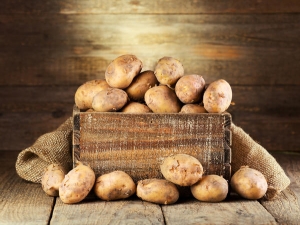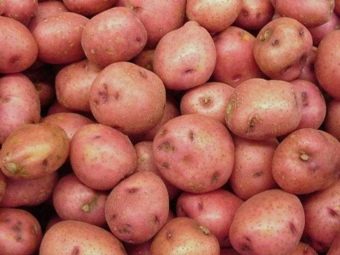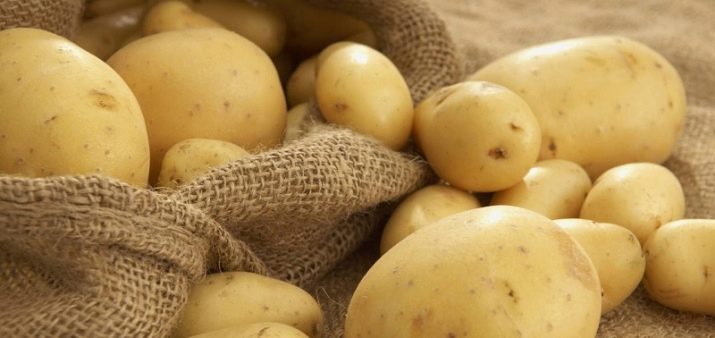What potato varieties are suitable for different regions of the country?

Potatoes are grown throughout our country. This is perhaps the most common food product.From it you can cook a lot of different dishes - soups, casseroles, pies, salads. In order to have a harvest every year, it is necessary that the variety matches the climate of the area.
Central European part
The climate of the European part of Russia, its central zone, is characterized by cold winters and warm, even hot summers with optimum humidity. A good time for growing vegetables is from the second half of May to the end of September. For planting in this region, as well as for the Moscow region, early and middle early varieties are suitable.
Due to the fact that the weather is unpredictable, preference should be given to those who have increased adaptive abilities for any conditions.
Consider some of them.
- "Rocco" - the most fruitful of those presented below. The variety is universal, early ripe, tubers are even, large, tasty. Quietly transfers transportation and long storage. Of the advantages can be noted immunity to various diseases.
- "Bellarosa" - superearly, with reddish tubers, rough skin. Large, productive. Launched in Germany. The flesh is beige, tasty. Universal. Resistant to bacterial lesions.
- "Rosara" - also a product of breeders in Germany, mid-early. Tubers oblong, pinkish with yellow flesh of good taste, also universal.
- "Nora" - early ripe grade. Potatoes oval, large. Coloring of a skin and pulp yellow.
- "Bashkir" - early Russian variety. Large round potato with reddish skin, white inside, very tasty, for table purpose.
- "Pogarsky" - Another domestic variety, ripens early. Potatoes medium and large, the color of the skin is light beige, white flesh. It has a table purpose, taste is high.
In this region, medium and medium late varieties are grown.
Siberian District
The climate of Siberia is very diverse. If in the north of the region there are completely unsuitable conditions for the cultivation of vegetables, then in the southern and south-western part it is quite possible to grow not only potatoes, but even tomatoes and cucumbers in open ground. Altai is a favorable area in this regard.
Summer in this area although hot, but relatively short. Therefore, potatoes for Siberia should be early and very early ripening. Late varieties here simply do not have time to form and ripen. And also an important advantage is resistance to various natural anomalies and diseases.
It should choose high-yielding, large-fruited varieties with simultaneous maturation of tubers.
Despite all the difficulties and obstacles, about fifty varieties are cultivated in Siberia, and very successfully. Of course, it is better to give preference to Russia, but among foreign ones there are those that have stood the test of harsh conditions.
Of the most common can be called several varieties.
- "Alyona". Yield and reliable domestic variety. It was created about thirty years ago, but is still successfully grown by Siberian gardeners. It is characterized by resistance to crayfish and scab, and also tolerates drought. The bulbs are leveled in size, smooth, round in shape, red, the flesh is light yellow. Of these, you can make delicious mashed potatoes, chips, or just fry. Another advantage of the Alena potato is that, thanks to even tubers, it is suitable for mechanical harvesting.
- "Adretta". The old, proven German variety showed itself well in Siberia. Productivity is high. Potato variegated, yellow on the outside and inside, crumbly, very tasty. Mashed potatoes turn out simply incomparable. Quietly related to the absence of rain and excess moisture in the soil. Resists cancer, potato nematode and late blight.
- "Zhukovsky Early." His name indicates that he has ripened early. Tubers are rounded, larger than average. The peel is smooth, dense, pink.The flesh is white, does not change color after cutting, the taste is excellent. Long retains an attractive appearance. The grade is not subject to diseases.
- "Tuleevsky." Russian variety, bred and zoned in Siberia. It is therefore ideal for growing in the area of risky farming. Large yellow potatoes of very good, even excellent taste. Forms a crop, regardless of the weather. Resistant to cancer, but is affected by nematode and scab.
- "Luck". The variety is also the result of domestic breeding. Potatoes are rounded, the color of the skin is light beige, white flesh. Potatoes can easily grow in arid conditions. Quite well withstands viral diseases and phytophthora, but under adverse conditions can be affected by scab. Productivity is consistently high.
In addition to the usual, traditional varieties, for the Siberian expanses suitable frost-resistant elite, derived in Canada and the United States, and recommended for cultivation in the harsh Alaska climate.
- Crenbury Red - oval-shaped potatoes, medium size, with a red skin. The flesh is pinkish, the color does not change during cooking. The taste is a bit unusual, gentle and pleasant. You can cook any dishes.
- Hucklebury Gold. Tubers of lilac color with creamy flesh, a peculiar taste. The variety is suitable for mashed potatoes or broiling.
- Hacklebury. Canadian variety, another name for it is "Red Cranberry". Unusual, bright red skin and pulp, while cooking the color is fully preserved.
Ural region
Ural also belongs to the zone of risky farming. The climate is often unpredictable, the summer is short. This means that those varieties that grow well and bear fruit in Siberia are suitable for the Urals. But you can plant and potatoes grown in the northwest.
Below is a description of some varieties.
- Nevsky. Medium early, table, fruitful. Medium-sized potatoes, yellowish with a cream shade. The flesh is white, does not boil soft during cooking. The taste is good. It is not affected by potato cancer, but it can be slightly damaged by late blight.
- "Kamensky." New early variety with oblong tubers of red color. Productivity with good care can increase. The flesh is yellow, good taste. Immune to cancer and mosaic of potatoes, but not protected from the effects of phytophthora and nematodes.
- "Irbitsky". Another novelty for cultivation in the Ural region. Mid-season, high-yielding. The potatoes are globose, large, with red skin and light yellow flesh. It has genetically inherent immunity against viral diseases and cancer. The resistance to late blight is average.
- "Impala". Early ripe. Tubers oblong, oval, medium size, yellow color. The flesh is also yellow, tasty. The yield is about average. Well resists cancer and nematode, but may suffer from phytophthora.
- "Gala". Another recently bred variety of medium early ripening. Medium-sized potatoes, elongated, with light yellow skin and slightly darker pulp, crumbly and tasty. Harvest consistently good. The value of this variety is that it is resistant to potato cancer, the majority of viral diseases, nematode. Late blight is affected to a small extent.
For southern areas
In contrast to the Urals and Siberia, the climatic conditions of the southern regions are favorable for vegetable production. Here you can get two harvests of potatoes per season.
This can be hindered by long periods of drought at very high air temperatures and, accordingly, soil. A potato planted in such conditions is simply “baked” in the ground, because it is well known that this is a moisture-loving culture.
Especially for cultivation in the south, breeders deduce varieties with genetic resistance to prolonged heat and a limited amount of moisture, and, besides, early and extremely early maturation.
The best of all is the potato in these parts if it is planted in very early spring in the so-called February windows.
For the second crop, they are planted at the end of the summer, but regular and abundant watering is imperative here, which should be done in the morning when the earth cools a little after the night.
Here are some varieties suitable for cultivation in the southern areas:
- Nadiyny;
- Obrie;
- "Partner";
- Serpanok;
- Skarbnitsa;
- "Slav";
- "Typhoon";
- Agave;
- Vineta;
- "Riviera";
- Arrow;
- "Ovation".
Universal options
According to their characteristics and taste, potatoes are divided into four main groups.
- Dining varieties - are in high demand among a huge number of gardeners around the world. Differ in high productivity, the tubers leveled, average and large. Widely used in cooking for cooking a variety of dishes. They contain many useful and nutrients, including starch, have a good and excellent taste.
- Feed potatoes. As the name implies, it is usually used in animal husbandry to fatten livestock. The yield of this species is also high, the tubers grow very large, often of irregular shape. The taste is noticeably inferior to the varieties of table purpose.
- Technical grade varieties. Such potatoes go into industrial processing, they produce starch or alcohol. Potato size is medium and small. It is not used as a food, as it has a mediocre taste and contains a small amount of useful substances.
- Universal varieties. The most common, successfully combine the characteristics of table and fodder potatoes: consistently high yield, large-fruited and excellent taste.
The ripening terms of different varieties differ markedly.
Under this item, they can be divided into several categories.
- Early (or super early) - for example, "Ariel", "Impala", "Veneta", "Lapis lazuli". Ready to eat 55 to 70 days after landing. Immediately go into food, unsuitable for long-term storage. Tubers are usually medium sized.
- Early - such as "Zhukovsky Early", "Leader". They go immediately after the early maturity and are similar to them in many characteristics, are also intended for consumption, are not stored.
- Medium early. The following varieties are picking up the baton - “Red Scarlett”, “Ryabinushka” and the like. In many ways similar to previous ones.
- Mid-season. The varieties of this group ripen much later, they can already be laid for storage. Tubers are large and medium. Their taste rating is usually higher than that of the early ones. This, for example, the old variety "Sineglazka", as well as "Dubrava", "Victory", "Altair" and many others.
- Middle late. Immediately follow the average. Well kept, taste excellent. For example - "Lasok", "Asterix".
- Late varieties. The vegetation period is stretched out, thanks to which the tubers have time to accumulate a lot of nutrients, they have great taste. The peel is dense, which minimizes the risk of mechanical damage during storage and transportation. The late ones include the Zhuravinka, Zdabytak, Teterev and other varieties.
It should also highlight the most delicious and crumbly potato varieties. These include, for example, Bellaroza, Rosara, Gala, Picasso, Tuleyevsky, Impala, Rodrigo, Adretta, and the next generation of this variety, Vitara.
Experts all over the world constantly carry out a large selection work, derive new, elite varieties that can withstand various diseases and adverse weather conditions. Much attention is paid to increasing yields and improving taste.
There are several varieties of the elite of western selection.
- "Evolution". Early ripening. Large oval tubers, in their nest can be about twelve pieces, dark red with white flesh.Universal. It has increased resistance to scab and viruses.
- "Colombo". Top grade table grade. Gives consistently high yields, regardless of weather conditions. Round one-dimensional potatoes with amber-yellow skinned and lighter flesh of excellent taste.
- "Flamenco". Mid-season, high-yielding. Tubers are large, elongated, pink. Resistant to drought, disease and hot weather.
- "Arizona". Medium early, universal. Productivity is stable, high, does not depend on the weather. Potatoes large, with yellow skin and pulp, tasty.
The domestic elite is represented by several varieties.
- "Alyona".
- "Kamensky."
- "Irbitsky".
- "Gourmet". Maturation term is average. Unusual - the skin and pulp are purple. Tubers oblong medium size. Treats dietary products, contains many antioxidants. Poor tolerates low temperatures, needs watering.
The disadvantage of elite varieties is that they have to be updated every three to four years, as they tend to degenerate and reduce yields.
In various publications post reviews of cultivated varieties of potatoes, yield, taste, depending on weather conditions in one or another region. For example, the Ural gardeners often prefer to grow potatoes "Gala", "Impala", "Kamensky", "Luck." And so well succeed varieties such as "Adretta", "Nevsky", "Romano".
In Siberia, planted "Tuleevsky", "Ermak", "Zhukovsky".
In the Central areas of the range even more expanded.
The climate is different everywhere, but there is no friend to the taste and color. Therefore, it is impossible to give a single recommendation, which grade is better.
In the next video you will find an overview of the most productive varieties of potatoes.




































